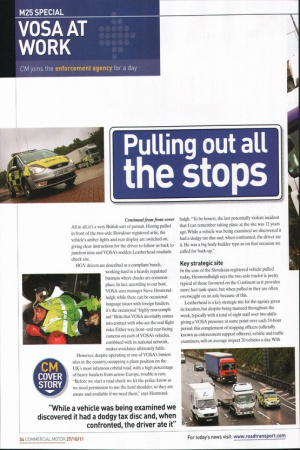Turning 25
Page 31

Page 34

If you've noticed an error in this article please click here to report it so we can fix it.
A celebration
The M25 turns 25 this year and to celebrate CM brings you the 25 most interesting facts about it – but who would have thought that Chris Rea and Bob Geldof had a special connection to it?
Words: David Cameron / Images: Rex Features
The M25 is the inspiration for the well-known 1989 Chris Rea hit album and song
Road to Hell.
At 117 miles, it is the world’s second longest orbital road, beaten only by the 121-mile Berlin Ring.
Before work started on it, the M25 was the subject of 39 public inquiries, which lasted for a staggering 700 days.
The first breakdown occurred at 11.16am on opening day – and our money is on it being a Leyland Roadtrain. According to the AA, of the 3.5m breakdowns they attended last year, 23,103 were on the M25. The most common call-outs are for punctures and blow-outs.
What’s the longest tunnel on the M25? If you think the answer is the Dartford Tunnel, you’d be mistaken. The Dartford Crossing (bridge and tunnel) are actually part of the A282, meaning that the M25 isn’t really a complete circle. The answer? It’s the 650m Holmesdale Tunnel, which passes beneath the Epping Foresters Cricket Club pitch.
Although the idea for a London orbital was first conceived 100 years ago, construction of the M25 didn’t start until the early 1970s. The first section to be completed (junctions 23 to 24 – South Mimms to Potters Bar) opened in 1975. The final piece of the motorway jigsaw (junctions 22 to 23 – London Colney to South Mimms), was opened 11 years later on 29 October 1986 by Prime Minister Margaret Thatcher.
Everyone has heard the story about the pensioner who got lost and drove around the M25 for two-and-a-half days. Whether or not it’s true is another matter, but what we do know for certain is that police once rescued an elderly lady who was cycling the wrong way in the slow lane at Godstone, Surrey.
The M25 is the most expensive motorway Britain has ever built, coming in at a whopping £909m – roughly £7.5m a mile.
Sir Bob Geldof was once a navvy working on the M25’s construction.
The motorway was designed to carry 88,000 vehicles a day. However, the heaviest traffic ever recorded in a single day is 196,000 at Heathrow between junctions 13 and 14.
North Ockendon is the only settlement of Greater London situated outside the M25.
There are 31 numbered junctions, or 33 if you include 1A &1B and 21 & 21A. The M25 connects with nine motorways – the M1, M3, M4, M11, M20, M23, M26, M40 and A1 (M).
Its signpost system follows five key destinations – Heathrow, Gatwick, Dartford Tunnel, Harlow and Watford. Before the M25 was fully joined up it was known as the M16.
A group of Christian evangelicals have declared junction 9 of the M25 “hexed” following a high number of accidents and footbridge suicides. They stage regular prayer meetings on a bridge over the motorway to cleanse the interchange. n














































